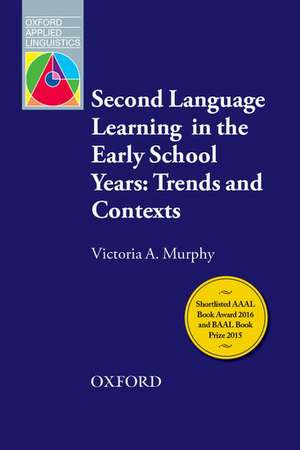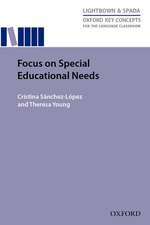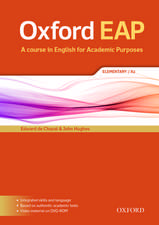Second Language Learning in the Early School Years: Trends and Contexts: An overview of current themes and research on second language learning in the early school years: Oxford Applied Linguistics
Autor Victoria A. Murphyen Limba Engleză Paperback – 30 apr 2014
Din seria Oxford Applied Linguistics
- 23%
 Preț: 492.12 lei
Preț: 492.12 lei - 8%
 Preț: 442.63 lei
Preț: 442.63 lei - 8%
 Preț: 421.50 lei
Preț: 421.50 lei - 6%
 Preț: 429.02 lei
Preț: 429.02 lei -
 Preț: 457.46 lei
Preț: 457.46 lei - 8%
 Preț: 420.63 lei
Preț: 420.63 lei - 8%
 Preț: 421.74 lei
Preț: 421.74 lei - 23%
 Preț: 444.59 lei
Preț: 444.59 lei -
 Preț: 462.98 lei
Preț: 462.98 lei - 23%
 Preț: 391.58 lei
Preț: 391.58 lei - 23%
 Preț: 392.34 lei
Preț: 392.34 lei - 23%
 Preț: 429.56 lei
Preț: 429.56 lei - 23%
 Preț: 429.24 lei
Preț: 429.24 lei - 23%
 Preț: 452.68 lei
Preț: 452.68 lei -
 Preț: 457.04 lei
Preț: 457.04 lei -
 Preț: 457.04 lei
Preț: 457.04 lei -
 Preț: 456.06 lei
Preț: 456.06 lei -
 Preț: 475.28 lei
Preț: 475.28 lei -
 Preț: 457.42 lei
Preț: 457.42 lei - 23%
 Preț: 450.96 lei
Preț: 450.96 lei -
 Preț: 459.49 lei
Preț: 459.49 lei -
 Preț: 466.24 lei
Preț: 466.24 lei
Preț: 457.20 lei
Nou
Puncte Express: 686
Preț estimativ în valută:
87.48€ • 91.59$ • 72.39£
87.48€ • 91.59$ • 72.39£
Carte disponibilă
Livrare economică 17-31 martie
Preluare comenzi: 021 569.72.76
Specificații
ISBN-13: 9780194348850
ISBN-10: 0194348857
Pagini: 223
Dimensiuni: 157 x 235 x 12 mm
Greutate: 0.32 kg
Editura: Oxford University Press
Colecția OUP Oxford
Seria Oxford Applied Linguistics
Locul publicării:Oxford, United Kingdom
ISBN-10: 0194348857
Pagini: 223
Dimensiuni: 157 x 235 x 12 mm
Greutate: 0.32 kg
Editura: Oxford University Press
Colecția OUP Oxford
Seria Oxford Applied Linguistics
Locul publicării:Oxford, United Kingdom
Recenzii
'Murphy provides a systematic analysis of different second language learning contexts involving younger learners, closely examining the strengths and weaknesses of these contexts. She also provides useful practical and conceptual guidance for a better understanding of these contexts, with the conviction that bilingualism is an asset. Consequently, from whatever the setting and position the reader is in, this is definitively a book to read and to keep close-by for aninformative and consistent "bird's-eye view" of young second language learners.'
'It is refreshing to read a book about young children learning languages that lives fully up to its title... In this book, although English receives a sizeable amount of attention, it is not the only language treated and we are taken into an array of different social and political circumstances in which learning a language is central to a child's wellbeing...The reports of research in this book set up comparisons and contrasts that offer valuable new insights andareas for reflection...
The book's major contribution is that it attempts to gather together research and to make the point that when we are dealing with school-based learning, there is much in the messiness of the contexts of real life to obscure or enrich what the Age Factor brings to the debate and much that we can do through the use of resources or the application of intelligence and good will to make the best of the situation. I wish I could be sure that policy makers as well asteachers and research students would read the book and take heed.'
'It is refreshing to read a book about young children learning languages that lives fully up to its title... In this book, although English receives a sizeable amount of attention, it is not the only language treated and we are taken into an array of different social and political circumstances in which learning a language is central to a child's wellbeing...The reports of research in this book set up comparisons and contrasts that offer valuable new insights andareas for reflection...
The book's major contribution is that it attempts to gather together research and to make the point that when we are dealing with school-based learning, there is much in the messiness of the contexts of real life to obscure or enrich what the Age Factor brings to the debate and much that we can do through the use of resources or the application of intelligence and good will to make the best of the situation. I wish I could be sure that policy makers as well asteachers and research students would read the book and take heed.'














